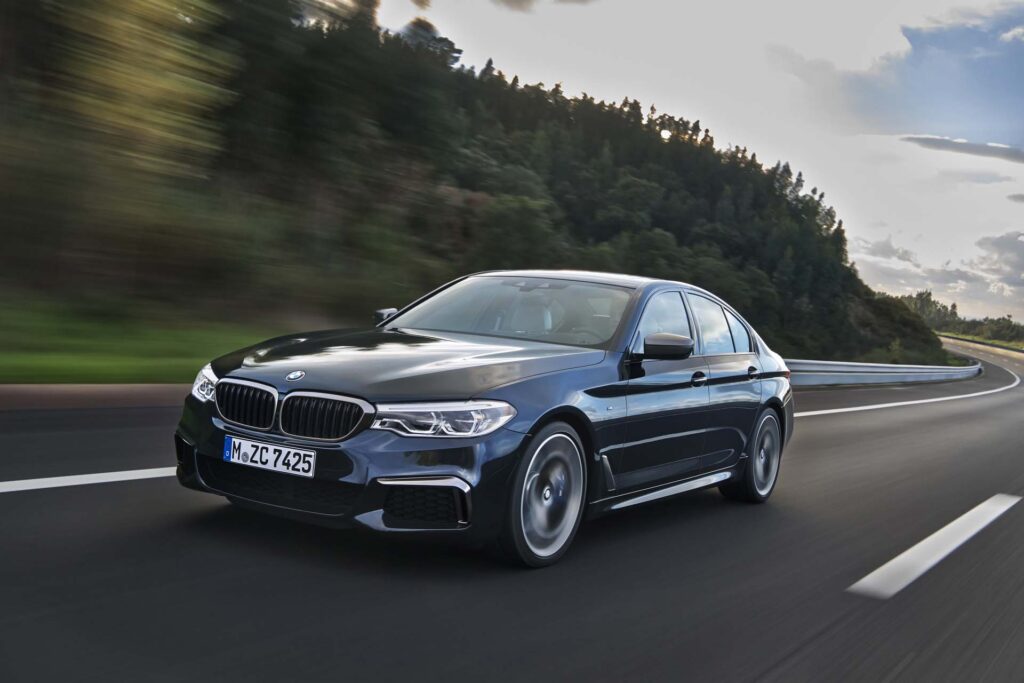
The news this year for the 5-Series is the addition of a V-8-powered M550i xDrive, a diesel-powered 540d, and a plug-in hybrid 530e to complement the turbo-4 and turbo-6 530i and 540i respectively.
All models are mated to an excellent 8-speed automatic.
The base turbo-4 is excellent in many applications, especially in the 530i, but it’s the transmission, ride, and handling that has us gobsmacked. The 5-Series earns two points above average on our performance scale. (Read more about how we rate cars.)
With 4-, 6-, and 8-cylinder options, the 2018 BMW 5-Series performance range can be intimidating—and that’s before we’ve considered the hybrid. Let’s unpack delicately then.
The first stop for many buyers will be the turbo-4 found under the hood of the 530i. That corporate inline-4 makes 248 horsepower and 258 pound-feet of torque, and can power the rear wheels as standard or all four via the optional all-wheel drive, which is called xDrive. It propels the 5-Series up to 60 mph in about six seconds, which should be enough for most buyers. It’s only pressed to pull off rushed passing situations.
The next step up for some shoppers will be the 530e, which is powered by a turbo-4 mated to a 9.2-kwh battery and electric motor for a combined output of 248 hp and 310 lb-ft. In our drives, the battery and combustion engine seamlessly hand off power to one another, with an imperceptible shift in performance from the 530i to the 530e—they both manage the 60 mph sprint in 6.1 seconds. Like the 530i, the 530e can come in rear- or all-wheel drive configurations. The 530e’s extra weight is apparent in cornering and weight transfer; the hybrid running gear adds more than 600 pounds to the overall mass.
BMW aficionados will recognize the 540i badge, but perhaps not its new engine configuration. A turbo-6 replaces the V-8 historically found in 540i models, and we’re not bemoaning the loss of two cylinders. The turbo-6 makes 335 hp and 332 lb-ft of torque. It’s zesty enough to make the run up to 60 mph in less than five seconds with rear- or all-wheel drive, which was the province of the M5 not long ago.
This year a turbodiesel 540d joins the fray with a 3.0-liter inline-6 cribbed from the X5d. The engine makes roughly 250 horsepower, but its trick is efficiency—provided you’ve skipped the hybrid version. The 540d is available only with all-wheel drive, and it returns 30 mpg combined, according to the EPA.
For 2018, the 5-Series gets temptingly closer to the vaunted M5 with the exhaustively named M550i xDrive. It mates a 4.4-liter turbocharged V-8 with all-wheel drive running gear to charge up to 60 mph in less than four seconds. The 456 hp and 480 lb-ft would be enough to thrill most drivers—at least it should be enough. (We haven’t yet driven one, but will report back as soon as we have.)
BMW will indulge our impatience with an M5 sometime soon, which undoubtedly will feature a six-figure price tag.
Most models can be equipped with rear-wheel steering and adaptive dampers (only the 530e can’t have rear-wheel steering) that helps improve the car’s ride and behavior. Adaptive dampers can dial up the comfort or firmness of the 5-Series with predictable stops between Comfort and Sport settings. A secondary sport setting is as firm as it gets, but it still wasn’t jarring on most roads.
Our gripe with the rear-wheel steering setup is a subjective one: it never felt natural. On canyon corner-carving drives, when the system subtly steered the rear wheels in the same direction as the fronts, it felt like the rear end was skating around the corner. At slower speeds, the system can counter steer the rear wheels to shrink the 5-Series’ long wheelbase to make it more maneuverable.
In all 5-Series the steering setup is generally good, with a direct electrically powered system that responds appropriately. In some drives, we noticed the variable rack included on the rear-wheel steering setup could speed up the wheel beyond expectations as speed increased, which resulted in several small mid-corner corrections.



